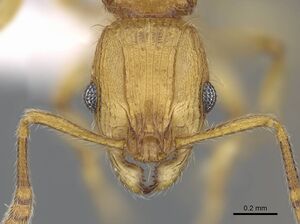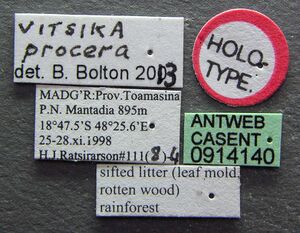Vitsika procera
| Vitsika procera | |
|---|---|

| |
| Scientific classification | |
| Kingdom: | Animalia |
| Phylum: | Arthropoda |
| Class: | Insecta |
| Order: | Hymenoptera |
| Family: | Formicidae |
| Subfamily: | Myrmicinae |
| Tribe: | Crematogastrini |
| Genus: | Vitsika |
| Species: | V. procera |
| Binomial name | |
| Vitsika procera Bolton & Fisher, 2014 | |
All material was retrieved from litter samples in rainforest, except for a single worker, which was acquired by beating low vegetation in rainforest.
Identification
Bolton and Fisher (2014) - Very similar to Vitsika suspicax, but most samples of procera are distinguished by having a thicker, less gracile petiole node, which tends to be narrower, has a more narrowly convex dorsal margin in posterior view, and has conspicuous costulate to rugulose sculpture anteriorly, laterally, and usually also posteriorly. The shape of the petiole node in profile shows some variation, the significance of which is not immediately apparent. In some specimens of procera the bluntly rounded anterodorsal angle of the node is the highest point in profile. The dorsal surface is only shallowly convex, and slopes downward posteriorly from the anterodorsal angle; the dorsum then meets a differentiated short posterior face through a blunt and rounded angle (e.g. procera type-series). However, in others the dorsum is shorter, distinctly more strongly convex, and rounds much more broadly into the posterior face, to such an extent that in some the two faces are not differentiated. The significance of this variation cannot be estimated at present, but two possibilities present themselves: first, that more than one sibling species currently resides under the name procera; second, that procera specimens are really nothing more than isolated strongly sculptured examples of suspicax. Nest series of a decent size, of both nominal forms, will be necessary before these alternatives can be resolved.
Keys including this Species
Distribution
Endemic to Madagascar.
Latitudinal Distribution Pattern
Latitudinal Range: -18.78472222° to -18.78472222°.
| North Temperate |
North Subtropical |
Tropical | South Subtropical |
South Temperate |
- Source: AntMaps
Distribution based on Regional Taxon Lists
Malagasy Region: Madagascar (type locality).
Distribution based on AntMaps
Distribution based on AntWeb specimens
Check data from AntWeb
Countries Occupied
| Number of countries occupied by this species based on AntWiki Regional Taxon Lists. In general, fewer countries occupied indicates a narrower range, while more countries indicates a more widespread species. |

|
Estimated Abundance
| Relative abundance based on number of AntMaps records per species (this species within the purple bar). Fewer records (to the left) indicates a less abundant/encountered species while more records (to the right) indicates more abundant/encountered species. |

|
Biology
Castes
Males have yet to be collected.
Images from AntWeb
   
| |
| Holotype of Vitsika procera. Worker. Specimen code casent0914140. Photographer Michele Esposito, uploaded by California Academy of Sciences. | Owned by CAS, San Francisco, CA, USA. |
Nomenclature
The following information is derived from Barry Bolton's Online Catalogue of the Ants of the World.
- procera. Vitsika procera Bolton & Fisher, 2014: 89, figs. 111-113, Map 159 (w.q.) MADAGASCAR.
Unless otherwise noted the text for the remainder of this section is reported from the publication that includes the original description.
Description
Worker
(holotype in parentheses). TL 3.0–3.4 (3.0), HL 0.67–0.76 (0.67), HW 0.54–0.64 (0.55), CI 81–84 (82), SL 0.47–0.56 (0.48), SI 83–89 (87), PW 0.41–0.51 (0.41), WL 0.86–0.98 (0.86) (12 measured).
Eye with 7–8 rows of ommatidia, and with 9–10 ommatidia in the longest row; EL 0.16–0.19 (EL/HW 0.29–0.31). MfL 0.56–0.70 (MfL/HW 1.00–1.10). Diameter of annulus of propodeal spiracle usually greater than the thickness of the propodeal spine at its midlength. Petiole node in profile more or less erect with respect to the peduncle, the node not obviously inclined posteriorly; node often with a defined posterior surface that is differentiated from the oblique dorsum, but in some the dorsum rounded. Sculpture of petiole node conspicuous: in profile with distinct costulae or rugulae that ascend the anterior surface, travserse the sides near the dorsum, and usually overlap onto the posterior surface; in some specimens the costulae extend across the posterior surface. Height of petiole node in posterior view (from midpoint of the dorsal margin of the foramen to the apex) 0.86–1.00 × its maximum width. In dorsal view postpetiole 1.10–1.18 × broader than long; maximum width of postpetiole < 1.20 × the length of a propodeal spine; maximum width of postpetiole 0.93–1.07 × the distance between the apices of the propodeal spines. Length of postpetiole node in profile about equal to the height of the segment. Dorsum of postpetiole with weak punctulate sculpture over most or all of the surface, and laterodorsally with longitudinal costulae visible. Full adult colour yellow.
Queen
(gyne). Ergatoid only known. The single ergatoid specimen available is almost exactly like the worker, but retains a small median ocellus, and is larger than most workers, HL 0.77, HW 0.64, CI 83, SL 0.54, PW 0.49, WL 1.00, MfL 0.68 (1 measured). The relative dimensions of the eye, petiole, and postpetiole are as in the worker. It is possible that the two largest individuals regarded as workers here (HL 0.74–0.76, HW 0.60–0.64, MfL 0.66–0.70) may in fact be ergatoids in which the ocelli are wholly supressed. MfL in these two specimens is decidedly above the range shown otherwise, which is MfL 0.55–0.58. If so, this would parallel the situation seen in Eutetramorium mocquerysi, where the ergatoid can only be distinguished from the worker by dissection of the reproductive system.
Type Material
Holotype worker (top specimen of 3 on pin), Madagascar: Prov. Toamasina, P.N. Mantadia, 895 m., 18°47.5’S, 48°25.6’E, 25–28.xi.1998, sifted litter (leaf mold, rotten wood), rainforest, 111(8)-4, CASENT0127747 (H.J. Ratsirarson) (California Academy of Sciences). Paratypes. 2 workers mounted on same pin, below the holotype; 3 workers on one pin, with same data but #111(20)-6, CASENT0192030; 1 worker with same data but #111(5)-4, without a CASENT number (CASC).
References
- Bolton, B. & Fisher, B.L. 2014. The Madagascan endemic myrmicine ants related to Eutetramorium (Hymenoptera: Formicidae): taxonomy of the genera Eutetramorium Emery, Malagidris nom. n., Myrmisaraka gen. n., Royidris gen. n., and Vitsika gen. n. Zootaxa 3791:1–99. doi:10.11646/zootaxa.3791.1.1
References based on Global Ant Biodiversity Informatics
- Bolton B., and B. L. Fisher. 2014. The Madagascan endemic myrmicine ants related to Eutetramorium (Hymenoptera: Formicidae): taxonomy of the genera Eutetramorium Emery, Malagidris nom. n., Myrmisaraka gen. n., Royidris gen. n., and Vitsika gen. n. Zootaxa 3791(1): 1-99.

